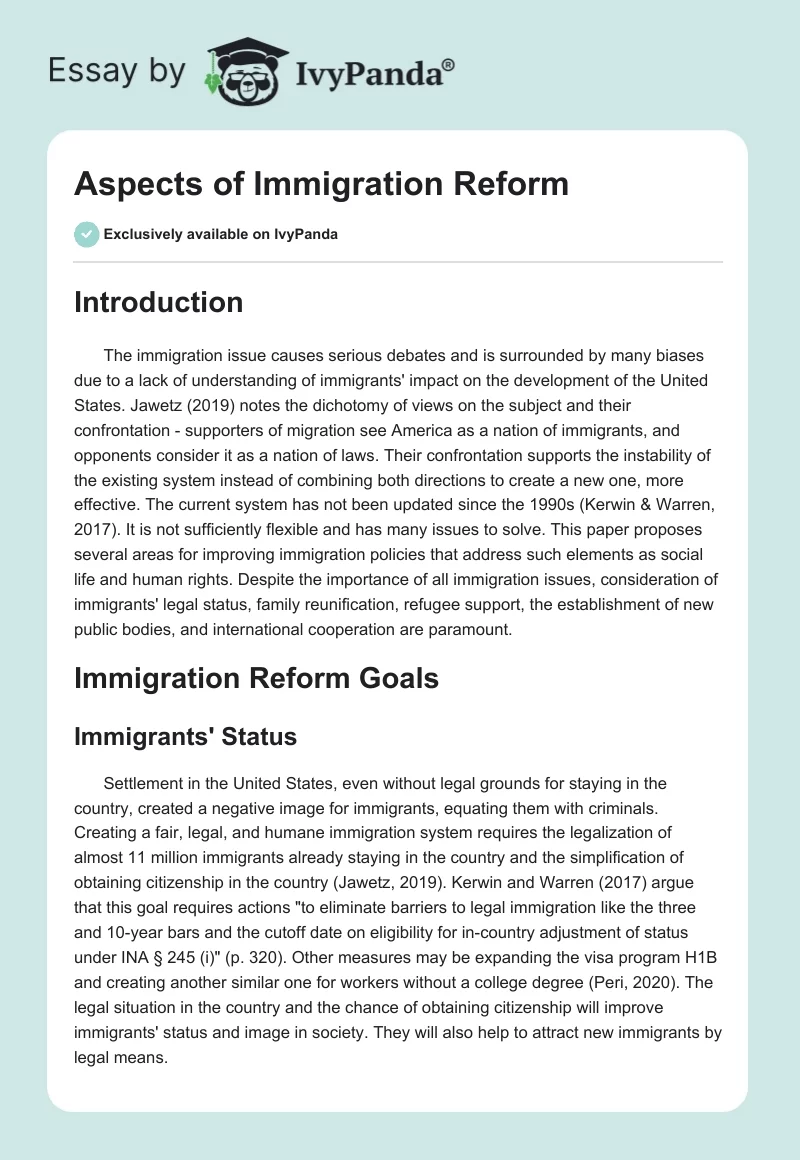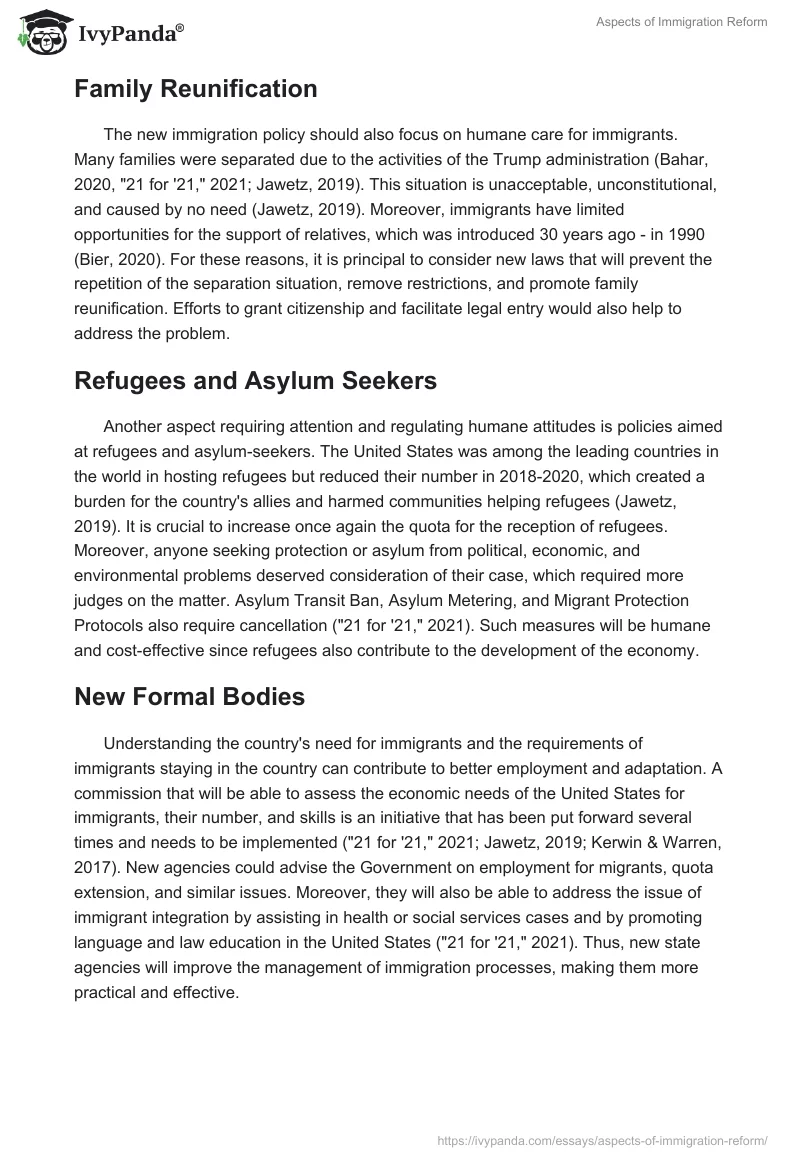Introduction
The immigration issue causes serious debates and is surrounded by many biases due to a lack of understanding of immigrants’ impact on the development of the United States. Jawetz (2019) notes the dichotomy of views on the subject and their confrontation – supporters of migration see America as a nation of immigrants, and opponents consider it as a nation of laws. Their confrontation supports the instability of the existing system instead of combining both directions to create a new one, more effective. The current system has not been updated since the 1990s (Kerwin & Warren, 2017). It is not sufficiently flexible and has many issues to solve. This paper proposes several areas for improving immigration policies that address such elements as social life and human rights. Despite the importance of all immigration issues, consideration of immigrants’ legal status, family reunification, refugee support, the establishment of new public bodies, and international cooperation are paramount.
Immigration Reform Goals
Immigrants’ Status
Settlement in the United States, even without legal grounds for staying in the country, created a negative image for immigrants, equating them with criminals. Creating a fair, legal, and humane immigration system requires the legalization of almost 11 million immigrants already staying in the country and the simplification of obtaining citizenship in the country (Jawetz, 2019). Kerwin and Warren (2017) argue that this goal requires actions “to eliminate barriers to legal immigration like the three and 10-year bars and the cutoff date on eligibility for in-country adjustment of status under INA § 245 (i)” (p. 320). Other measures may be expanding the visa program H1B and creating another similar one for workers without a college degree (Peri, 2020). The legal situation in the country and the chance of obtaining citizenship will improve immigrants’ status and image in society. They will also help to attract new immigrants by legal means.
Family Reunification
The new immigration policy should also focus on humane care for immigrants. Many families were separated due to the activities of the Trump administration (Bahar, 2020, “21 for ’21,” 2021; Jawetz, 2019). This situation is unacceptable, unconstitutional, and caused by no need (Jawetz, 2019). Moreover, immigrants have limited opportunities for the support of relatives, which was introduced 30 years ago – in 1990 (Bier, 2020). For these reasons, it is principal to consider new laws that will prevent the repetition of the separation situation, remove restrictions, and promote family reunification. Efforts to grant citizenship and facilitate legal entry would also help to address the problem.
Refugees and Asylum Seekers
Another aspect requiring attention and regulating humane attitudes is policies aimed at refugees and asylum-seekers. The United States was among the leading countries in the world in hosting refugees but reduced their number in 2018-2020, which created a burden for the country’s allies and harmed communities helping refugees (Jawetz, 2019). It is crucial to increase once again the quota for the reception of refugees. Moreover, anyone seeking protection or asylum from political, economic, and environmental problems deserved consideration of their case, which required more judges on the matter. Asylum Transit Ban, Asylum Metering, and Migrant Protection Protocols also require cancellation (“21 for ’21,” 2021). Such measures will be humane and cost-effective since refugees also contribute to the development of the economy.
New Formal Bodies
Understanding the country’s need for immigrants and the requirements of immigrants staying in the country can contribute to better employment and adaptation. A commission that will be able to assess the economic needs of the United States for immigrants, their number, and skills is an initiative that has been put forward several times and needs to be implemented (“21 for ’21,” 2021; Jawetz, 2019; Kerwin & Warren, 2017). New agencies could advise the Government on employment for migrants, quota extension, and similar issues. Moreover, they will also be able to address the issue of immigrant integration by assisting in health or social services cases and by promoting language and law education in the United States (“21 for ’21,” 2021). Thus, new state agencies will improve the management of immigration processes, making them more practical and effective.
International Arena
President Trump’s administration has pursued a comprehensive anti-immigration policy, and some consequences need to be corrected. In particular, the ban on entry from countries of the Middle East and North Africa, where the Muslim population prevails, is discriminatory and contradicts American values (“21 for ’21,” 2021). This measure deprived America of many opportunities, in particular the involvement of talented STEM specialists, who are not represented enough in the country at the moment (“21 for ’21,” 2021). Lifting the ban will contribute to family reunification, recruitment in the United States, and rehabilitation of the country’s international image.
Conflicts, environmental and economic problems, and similar issues will continue to force people to seek protection in other countries daily. Immigration is becoming a global concern, and there is a need to work towards international cooperation on those issues. In particular, it is vital to rejoin the Global Compacts for Migration and Refugees presented by the United Nations (Bahar, 2020). Despite their non-binding nature, they can serve as the basis for creating new internal and international systems.
Conclusion
Potential Barriers
Many Americans worry that immigrants are taking their jobs, decreasing wages, and damaging the state budget. However, immigrants usually have a stimulating effect on the economy and contribute to creating new jobs, and it is crucial to convey this understanding to the population (Bean, 2020). An essential aspect of citizens’ dissatisfaction with the presence of immigrants is their low income, which in turn is provoked by the division between rich and poor (Bean, 2020). For this reason, immigration reforms should also be linked to national initiatives to increase workers’ earnings (Bean, 2020). The strengthening of the national economy and immigration issues are closely intertwined.
Need for Immigration Reform
The US can preserve its historical traditions and be a nation of immigrants and a nation of laws, creating an effective immigration policy. At the moment, there are many problems in the system, which subsequently led to the separation of families, a large number of illegal migrants, their criminalization, and similar issues. However, immigrants contribute to the development of the economy, not its decline. For instance, the aging of the nation leads to the problem of an insufficient working-age population, and immigrants fill this gap. They also take on hard and low-skilled work that Americans refuse and are ready to work at any time of the day.
Nevertheless, because immigration laws were adopted disorderly and inconsistent with each other, most of them are outdated, do not meet the requirements of the current time, or are inhumane. For these reasons, providing reform is critical for the stable development of the United States and for promoting humaneness in the world. This paper draws attention to such aspects as immigrants’ legal status, family reunification, refugee issues, the creation of new state agencies, and international cooperation.
References
21 for ’21: Fixing America’s immigration system. (2021). New American Economy. Web.
Bahar, D. (2020). The road to fix America’s broken immigration system begins abroad. Brookings. Web.
Bean, F. D. (2020). Why the United States must renew opportunities to achieve the American Dream in order to reform immigration policy. Journal of Policy Analysis and Management, 39(1), 274-279. Web.
Bier, D. J. (2020). Reforming the immigration system: A brief outline. Cato Institute. Web.
Jawetz, T. (2019). Restoring the rule of law through a fair, humane, and workable immigration system. Center for American Progress. Web.
Kerwin, D., & Warren, R. (2017). National interests and common ground in the US immigration debate: How to legalize the US immigration system and permanently reduce its undocumented population. Journal on Migration and Human Security, 5(2), 297–330. Web.
Peri, G. (2020). Should the US expand immigration? Journal of Policy Analysis and Management, 39(1), 266-266. Web.


